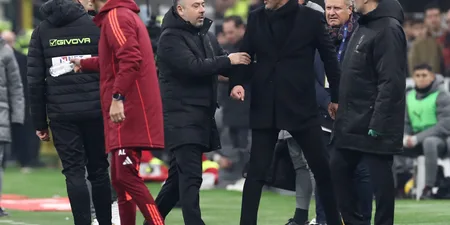Spending your hard-earned cash on a personal trainer to yell at you for an hour a week? Well don’t.
JOE is here to do it for free (you’ll just have to read this and imagine we’re screaming it at you like an ex-military PT).
The best bodybuilding brains the JOE office could muster have created a list of 14 golden rules to design your very own dynamite plan to get shredded for summer.
Part 1 of our DIY ‘get ripped quick’ scheme covered everything from picking the right training split to identify weak points to how to cram in those luxury muscles into your weekly plan.
Now we’re back dropping yet more knowledge bombs for Part 2. Here are five more essential tips to creating your own training masterplan –
6. Volume
This is one of the most fundamental factors in muscle growth.
The amount of volume or ‘work’ you are doing needs to be constantly increasing in order to keep your body guessing and your muscles growing.
Simply put – the number of reps and sets you do per workout. You can increase your volume by gradually increasing the weights you do, the number of reps you hit or the number of sets in a session.
Over the course of your training plan the volume should be increasing week on week.
This is why you should keep a training log to track progress on every exercise.
7. Reps and Sets
The number of reps you do per sets, the amount of sets you do per exercise and the number of exercises you can handle in a session will vary depending on your goals, your experience and even your age.
A pro bodybuilder could be hitting up to 32 sets in total per session – but a beginner is probably looking at half that number.
For strength training you generally see programmes with lower reps (1-6) and higher numbers of sets (3-10) – this is for maximum strength gains.
But for aesthetics or getting shredded for summer people tend to benefit from rep ranges of 6-8 reps or 8-12 depending on the exercise.
Muscles with slow twitch fibres (like glutes and hamstrings) benefit from lower reps and heavier weights.
Whereas fast twitch fibres (endurance muscles like quads and delts) are best targeted with higher rep ranges.
To really exhaust muscles like arms, calves, quads and delts you can really crank the rep ranges up from anything between 12 to 30.
8. Change Up
Your body is a crafty machine – and it will constantly try and adapt to the training you are doing.
So to keep growing, getting stronger and burning fat you need to keep challenging it with heavier weights and more training volume.
Don’t let your body get used to the training you are doing – or your gains will stagnate and your metabolism will slow.
This is why it is important change up the exercises you do on each body part anywhere from 4-8 weeks (depending on how advanced you are).
So if you’re on a 12-week plan – maybe look at introducing new exercises on the half way point to give your body a new stimulus. If you’ve been hitting straight back squat in the first half, maybe change it for front squat or hack squat.
Or if you have been targeting your hamstrings with Romanian barbell deadlifts switch them up to tougher dumbbell deadlifts.
9. Intensity
Another way to keep your body constantly having to adapt is to increase the intensity of your workouts.
This can include shortening your rest periods – from 90 seconds to 60 seconds or less betweens sets.
But you can also introduce intensity boosters to your programme.
Drop sets are one – this is where you do say 10 reps, then decrease the weight and do another 10 reps and keep decreasing in increments until your muscles are fatigued.
Another is supersets or giant sets – this is where you combine two or more exercises per set and go from one to the next with no rest in between.
It’s another great way to increase the intensity of your workout and exhaust your muscles.
10. Recovery
You grow when you rest, not when you’re training. That’s just a cold, hard fact – so obviously recovery is key. If you’re still aching like you’ve run a marathon the next time you legs or you’re waking up in the morning still walking like a Thunderbird then you’ve probably not recovered.
You need to factor recovery days into you’re training – because not even the top bodybuilders can train day in day out, week in week out without putting their feet up and giving their muscles some respite.
You should probably take a recovery day every two or three days.
Don’t forget a key part of your recovery is sleep. Get a solid 8-10 hours of unbroken sleep because this is when your brain recharges, your muscles repair and your body releases those growth hormones.












































